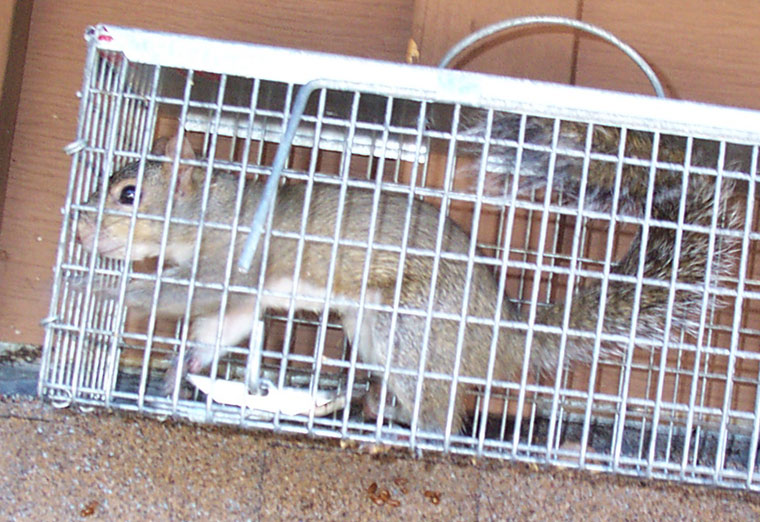- info@wildlife-removal.com
Call us for help in your town
Wildlife Removal Education
5 Signs You Have Squirrels in the Attic
Need squirrel removal in your hometown? We service over 500 USA locations! Click here to hire us in your town and check prices - updated for year 2020.
As with most wild animal invasions, there's a pretty good chance that you won't see a squirrel living in your property until it is too late. By "too late", we mean that the squirrel has had enough time to do a considerable amount of damage, spread disease, or generally make a damn nuisance of itself. If you have ever had a squirrel living in your attic or elsewhere on your property, you'll know that they are cute animals, yes. They are also pests - they will eat food that you don't want them to eat, they'll keep coming back all the time you allow them too, and it won't be long before they've broken into your property.

There are 5 signs of an attic-squirrel situation:
1 - A weird smell.
Most wild animals have a ‘weird' smell about them - it's a little musty, almost like how a hamster would smell in a cage filled with sawdust. You won't always smell the animal if you are downstairs and the squirrel is hanging out up in the attic, but the closer you are to the animal, the worse the smell will get.
As well as the musty odor of a living squirrel in your home, dead squirrels will also give off a rancid smell that gets worse the longer you leave it.
2 - Odd noises.
Squirrels make quite the interesting array of sounds and noises as they go about their lives, but they aren't always vocal noises. Some of them are just noises that the animal makes accidentally, such as scuffling and muffled thudding sounds as it squeezes through holes and into wall cavities.
Squirrels chew a lot, so you might hear chewing noises, also, as with rodents, this is more a noise that you will hear during the night, when everything else is quiet around you. Squirrels are active during the day mostly - first thing in the morning and then in the evening. They don't usually come out after dark, although unusual behavior is often spotted from wild animals, particularly in urban habitats. They don't seem to like the heat of the midday sun too much either - they like to siesta around lunchtime.
These animals do make vocal noises - young squirrels in a nest will call, chatter, and whimper for their mother. Males will fight, scream and shriek at each other as they fight over mating rights and territories. Females will growl to keep intruders at bay, as well as chattering and scratching as it interacts with others of its kind. These creatures aren't quiet - if you keep an eye out for a while at the times that we recommend, there's a good chance you'll hear them if they are there.
3 - Physical damage.
Damage to your property is always a good sign that you have an animal invasion, although, it doesn't always point to the correct culprit. Mice and rats are also known for their chewing activity, and raccoons and opossums will also chew if they need to. The larger the animal, the louder the sounds will be (in most cases), so a squirrel will make slightly louder chewing noises than a mouse or a small rat, with raccoons making even louder noises still.
Physical damage can also come in other forms from squirrels - they will chew through electrical wiring (just like rodents), bark on trees (out in the yard), and will potentially even chew through the external parts of your building - the bits that you can see. If you see what looks to be chewed-away areas of your home, it must be investigated immediately.
4 - Evidence of nests.
You don't actually need to see the nest in order to know that there is one there. You might seen material that looks to have been chewed or town away from somewhere else, such as attic insulation. This will be where a mother has removed the material with the intention of using it as bedding or nesting material. Again, just like the other common signs of squirrels in the attic, this isn't a sign that can just point to the squirrel. Rodents also chew various material to make a more comfortable bed, and they're not the only ones.
5 - Waste material.
Although squirrel droppings can look similar to the feces left behind by other animals, any feces in your home or yard should be looked into, into more detail. You should do this whilst protecting yourself too, such as wearing eye protection and a breathing mask. If you don't have these things available, you may wish to consider calling in the professionals. Squirrel feces and urine can spread more diseases than the actual animal can, and in some cases, those diseases can be fatal.
All of these signs point to a squirrel invasion in the attic, but they aren't the only signs that you should look out for. If you see patches of fur, it's a good sign that squirrels are fighting with one another. This isn't good news for you - they probably won't take each other out like you'd hope. Squirrels fighting with one another means that the population is packed in that particular area. The more fighting you hear, the more squirrels there are. Large numbers will need to be dealt with.
Go back to the Squirrel Removal page, or learn tips to do it yourself with my How to Get Rid of Squirrels guide.


















